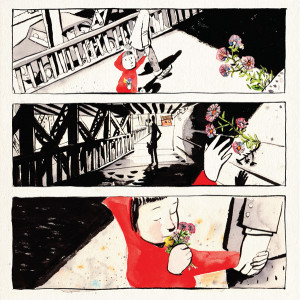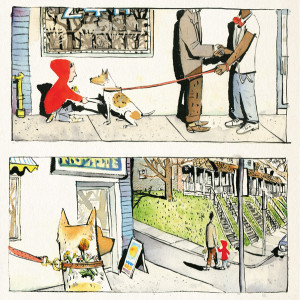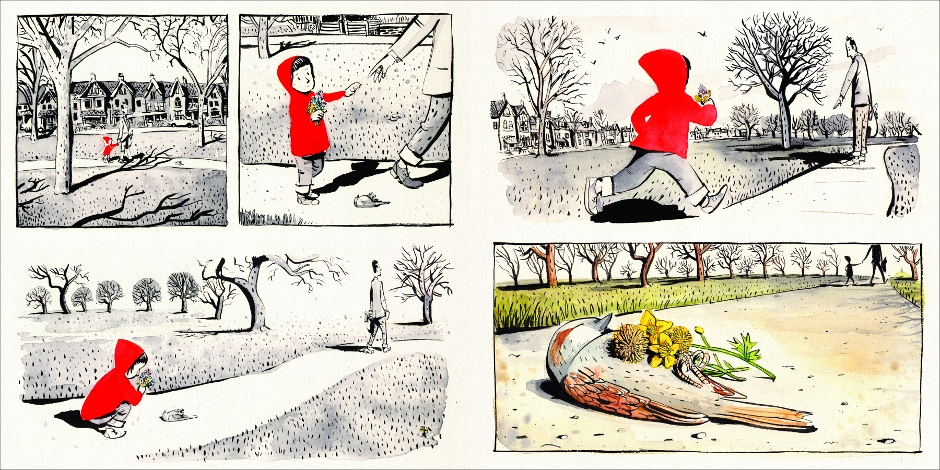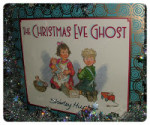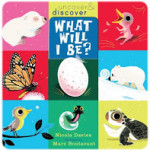In “The Accidental Graphic Novelist” (see Wordless Picturebooks: “A Voice for the Voiceless” Part 1), Shaun Tan speaks about giving a voice to the voiceless through the medium of the graphic novel. But being voiceless can mean many things; one can be voiceless in the same way as the characters Here I Am and The Arrival, but being voiceless can also mean that a subject cannot easily be expressed through words, which is what Tan calls “silent subjects”.
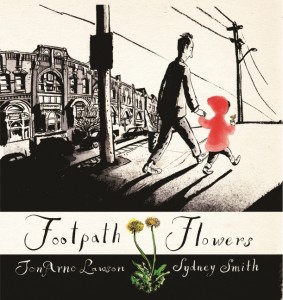 Footpath Flowers by JonArno Lawson (story) and Sydney Smith (artwork), published by Walker Books, is a perfect example of how elements of a graphic novel in wordless picturebooks allows to convey subjects not easily described by words. In this book, the reader follows a little girl and her father on their walk home from the shops through the busy streets of their neighbourhood. The dad, throughout, is busy either talking on the phone or chatting to passers-by and seems mostly distracted and unaware of his daughter who collects wild flowers whenever she finds them along the way and leaves them as gifts to people and other creatures as she passes them.
Footpath Flowers by JonArno Lawson (story) and Sydney Smith (artwork), published by Walker Books, is a perfect example of how elements of a graphic novel in wordless picturebooks allows to convey subjects not easily described by words. In this book, the reader follows a little girl and her father on their walk home from the shops through the busy streets of their neighbourhood. The dad, throughout, is busy either talking on the phone or chatting to passers-by and seems mostly distracted and unaware of his daughter who collects wild flowers whenever she finds them along the way and leaves them as gifts to people and other creatures as she passes them.
This story simply could not be told with words, and though not set up in a traditional graphic novel format, the use of sequenced panels allows to focus on those “silent” subjects, those subtle gestures, those delicate moments, those ethereal feelings, and that is exactly what Footpath Flowers celebrates with astute perceptivity.
The use of sequential panels not only slows down the walk, giving it an almost cinematic rhythm, but it also allows the reader to focus on all the details, highlighted by the use of close-up panels. We, as readers, are therefore given the insight of what the little girl is choosing to notice. Smith uses panels to control our perspective, and therefore our interaction with the story.
The ingenious use of panels an colour allows Smith to give centre-stage to the flowers (discarded as weeds by us unimaginative and constantly rushed adults): how the little girl meticulously collects them, how she gives them to people and creatures which she feels touched by the sight of: the homeless man sleeping on a bench, the dog, the dead bird, and eventually her family. Again, those silent feelings, so hard to articulate are so powerfully expressed by the paneled artwork.
Footpath Flowers is an ode to noticing the little things, that we, in our busy lives, fail to notice altogether. The little girl notices everything, not only the wild flowers trying to reclaim space taken by urbanization, but the tattoos on a man’s arm, a lady in a taxi, the dead bird which her father walks past unaware. Her father is completely oblivious to all this, his phone stuck to his ear most of the time; that phone is almost a symbol for everything that is wrong with our multimedia-obsessed fast-paced society. The narrative focuses on those simple, silent pleasures (or sorrows) for which we should pause, so that we can acknowledge them.
The playful use of colour is also remarkable – along the way only specific items are coloured: the flowers of course, but also some more random items such as the woman’s dress at the bus stop. But as the little girl and her father get nearer their home, colour spreads across the pages, linking the use of colour to what makes the little girl happy, what matters to her, but also a small triumph of nature over the grey city, culminating in the little girl and her family, content, in their back garden.
Footpath Flowers is a superb wordless book; its quiet beauty, its narrative full of unassuming grace will fill its readers with a real sense of wonder and yearning for those fleeting voiceless moments of perfection.


